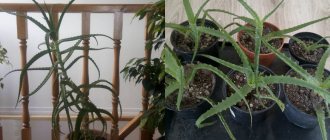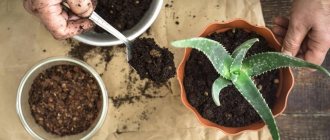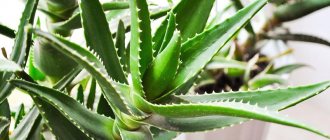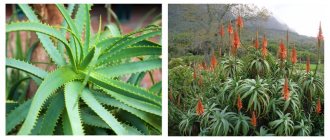The aloe plant, also known to many as agave, has earned popularity due to its healing properties. The leaves of this plant are used to prepare various healing ointments and tinctures. For this purpose, one plant is not enough, and it becomes necessary to grow several more specimens. Here, many amateur gardeners are faced with a problem: how to propagate aloe at home.
There are several ways to propagate aloe. They differ from each other in complexity and in the time that needs to be spent on one or another method. However, it cannot be said that one breeding method is worse and another is better. All of them are equally good and, if followed correctly, lead to positive results.
Features of aloe propagation
Aloe propagates indoors easily. After all, it is unpretentious, and attempts to breed it in 99% of cases end in success. Aloe, like many other succulents, is capable of propagation by the vegetative method, i.e. a part taken from one plant can be rooted and another flower can be grown from it.
Flower growers are familiar with several effective ways to propagate aloe indoors: leaves, children, cuttings, tops and seeds. Each of these methods has its own characteristics; even the most inexperienced gardener can propagate aloe.
Leaves
The least labor-intensive way to propagate agave at home is to propagate aloe leaves. First you need to carefully examine the leaves on the plant and choose the thickest and strongest of them. Such leaves are located at the bottom of the flower.
You should not choose leaves that have a yellowish or brownish tint. Those with stains on the surface are also not suitable.
These signs indicate that the leaf is unhealthy, and a damaged leaf will not grow into a strong plant. The selected leaf must be cut at its base as close to the stem as possible.
The cut leaf should be placed in a dark room and wait until the cut dries and a thin crust forms on it. As a rule, it takes no more than 3-5 days. When such a crust has appeared, you can move on to the next stage. You need to take 2-3 tablets of activated carbon, crush them into powder and sprinkle them on the cut area of the leaf. You can also use charcoal for this procedure. Immediately after this, you need to stick the leaf into the previously prepared soil so that the cut is underground at a depth of 3-5 cm.
An excellent soil for aloe will be soil with the addition of peat and sand. It is necessary to keep the soil moist at all times and not allow it to dry out. Well-moistened soil guarantees that young aloe will quickly take root and develop properly.
What to do if it doesn’t take root?
There may be several reasons why a young plant does not take root. Let's look at them.
Poor quality planting material . If a leaf or cutting was taken from a diseased aloe, it is unlikely to take root.- Incorrectly selected soil . You need to change the substrate: make the right soil mixture or buy a ready-made one. Suitable special soil for cacti.
- Incorrect care . The soil may be over-moistened. Aloe does not tolerate excessive watering. The substrate should be moistened only after drying.
Cuttings
Cuttings are a common method of propagating many indoor and garden plants. This method can be used at any time of the year. However, most experienced gardeners agree that it is easiest to achieve a positive result with its help in the summer.
Propagation of aloe by cuttings is possible if the plant has lateral branches along the stem. Just as in the case of agave propagation by leaves, cuttings should be cut almost at the very base, as close to the stem as possible. Cut cuttings should be prepared for planting by placing them for a week in a dark room with air humidity of at least 50%. This is necessary to dry the cut.
After 7 days, the cutting with the dried cut must be removed from its storage location, sprinkled with activated carbon on the cut and planted in the ground. It is enough to deepen the cuttings into the ground only 2-3 cm. If several cuttings are planted in one container at once, the distance between them should be at least 10 cm, since with good watering the aloe will begin to grow quickly and the plants will become crowded.
Tips for growing succulents
Professional gardeners recommend focusing on the following nuances of growing aloe:
- an adult, strong plant should stand on a windowsill that is lit most of the day;
- In spring and summer, agave is watered more often, in winter - as rarely as possible;
- aloe needs to be fed annually with mineral complexes and humus;
- if it was not possible to get rid of scale insects and mealybugs within 5 days using insecticides, the aloe must be immediately transplanted into new soil;
- Once a season, the agave needs to be sprayed with Fitosporin.
5/5 — (2 votes)
Children
Aloe shoots are called shoots that grow around the main flower from its root system. These shoots are often called appendages or root shoots. Propagation of aloe by this method occurs naturally and requires almost no human intervention. But aloe vera reproduces at home in this way slowly. It may take many years before the first shoots begin to emerge from the soil around an adult plant. Therefore, if the question is how to propagate aloe quickly, you should not rely on this method.
However, if shoots appear around the agave in a pot, you just need to separate the young shoots from the adult plant and plant them in a separate container. The main difficulty of this method is to avoid damaging the root system during replanting. Therefore, the soil must first be moistened, which will allow the shoots to be carefully removed.
When is the best time to do it?
It is better to start cuttings, dividing a flower or replanting in early spring. At this time, the natural phase of root growth begins. The optimal time for sowing seeds is the last ten days of winter.
The frequency of transplants depends on the stage of development of the succulent:
- aloe up to 2 years old is transplanted into a new pot annually;
- mature plants (up to 5 years) are rejuvenated every 2 years;
- old agave needs to be thinned out and replanted every 3 years.
In some cases (root rot, soil pests, infections, cramped pot), an extraordinary replanting may be required to save the plant.
Important! It is not recommended to propagate agave in the autumn-winter period. From October to February, the succulent is in a phase of passive growth, and an attempt to take root in a new place will be unsuccessful.
Tops
Propagating aloe from the top is the fastest way to get another plant. To do this, you just need to cut off the top of an adult flower so that it has at least 7 leaves. To achieve the best result, you can pre-soak the cut top of the plant in a solution with the addition of phytohormone growth.
Immediately after this, you need to place the top in a container with warm water, cut side down, and wait for the roots to form. Roots begin to appear after 7-10 days. As soon as the first signs of the formation of a root system appear, the plant must be immediately planted in the ground and actively watered, without allowing the soil to dry out.
Can it be grown from seeds?
Advantages:
- You can buy a bag of seeds at any flower shop;
- the percentage of plant survival when planted from seed is significantly higher than with other methods.
Flaws:
- this type of reproduction is the most complex and time-consuming;
- many gardeners complain about the poor quality of seeds.
Step-by-step instruction
Sequencing:
- Prepare a substrate from grain sand, leaf and turf soil.
- For planting, it is better to take fresh seeds with a shelf life of one year.
- All seeds undergo special treatment before planting.
Treatment consists of slightly damaging their protective shell to speed up germination. To do this you will need fine sandpaper. - The treated planting material is placed on a damp cloth. After about a week, shoots appear.
- Expanded clay drainage, calcined in the oven, is poured into a small pot. Soil is laid on the cooled drainage and seedlings are laid out. Then sprinkle with a thin layer of river sand, about 1 centimeter high.
- Carefully moisten the surface.
- The container must be covered with film to create a special microclimate.
- With the appearance of the first leaves, the film can be removed.
- Grown sprouts must be transplanted into large containers with the same soil composition.
Seeds
Propagating aloe by seeds is the most difficult and time-consuming of all ways to grow it at home. This method is complicated because it is rare to obtain plant seeds. They form in an adult plant only after a flowering period, and agave blooms rarely under indoor conditions - approximately once every 10 years.
If you still managed to get the seeds, you will have to germinate them according to the following scheme. First, you will have to select a suitable container, fill it with moist soil and deepen the seeds into the soil no more than 2-3 cm. Then the container with the seeds planted in the soil must be covered with glass or film and kept in a room where the temperature will be maintained around the clock at approximately + 21°C.
Aloe from seeds germinates in at least 7-10 days. Sometimes the period can reach 3 weeks. With the appearance of the first shoots, the film (or glass) can be removed. As soon as the seedlings grow and become stronger, they will need to be planted in separate containers. It is important that the composition of the soil in the container for replanting is exactly the same as in the previous one, otherwise the young, fragile aloe may die.
In about a year, the still small but already stronger plant will again have to be transplanted into a larger container, since by that time the young agave will already be cramped in the old pot. Propagating aloe vera from seeds is a difficult task that requires a lot of time and effort.
How to choose and prepare soil for growing aloe vera?
Aloe can grow in almost any soil.
Neutral or slightly acidic soil (PH 6.5-7), loose and well permeable to air and water, is best suited. To do this, you need to mix turf, leaf soil, humus and baking powder. Everything is taken in the ratio 2:2:1:1. Without air access to the roots, the plant develops poorly. Suitable baking powder:
- coarse sand;
- fine gravel;
- vermiculite;
- brick chips.
At the very bottom of the pot, pour 2 cm of drainage, then lay out the soil, and the final layer is baking powder.
Reference! Pots for transplanting shoots should be small in volume and with large drainage holes.
Recommendations for caring for young plants
Aloe is an unpretentious flower and does not require special care at home. But while the young agave plants are not yet strong enough, they should be treated with great attention. There are several simple rules on how to properly care for a flower.
In the room where the aloe is located, the temperature should not fall below +14°C or rise above +21°C. The indicated temperature range is the most optimal for this flower; at this temperature it will grow quickly.
Aloe loves bright light, but direct sunlight can burn the leaves of young plants, causing them to lose color. To grow a healthy and strong flower, you need to gradually accustom it to sunlight. It would be a good idea to place aloe on the balcony or in the yard for several hours a day, gradually increasing the time the plant stays in bright light. In the winter season, when there is not enough natural light, it would be useful to organize additional artificial lighting for aloe.
Adult plants can go without watering for a long time, but while the flower is still young and fragile, it is necessary to carefully monitor the condition of the soil and not allow it to dry out. A sufficient amount of moisture will allow the agave to grow quickly and develop properly. The flower does not need additional spraying of the leaves and maintaining high air humidity in the room; the moisture obtained from the soil is enough for it.
In the summer, the plant can be planted in a flower garden in the yard. But under no circumstances should you leave it there with the onset of autumn. After all, the homeland of aloe is Africa, where the climate is much warmer than ours and there are no frosts. For this reason, the flower does not tolerate frost and may die when the temperature drops.











